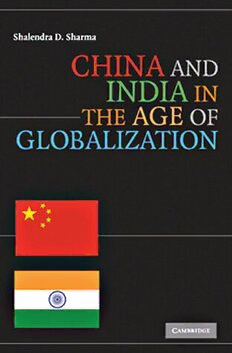
China and India in the Age of Globalization PDF
Preview China and India in the Age of Globalization
This page intentionally left blank china and india in the age of globalization TheriseofChinaandIndiaisthestoryofourtimes.Theunprecedentedexpansion oftheireconomicandpowercapabilitiesraisesprofoundquestionsforscholarsand policymakers.WhatforcespropelledthesetwoAsiangiantsintoglobalpacesetters, andwhatdoestheiremergencemeanfortheUnitedStatesandtheworld?With intimatedetail,ShalendraD.Sharma’sChinaandIndiaintheAgeofGlobalization explores how the interplay of sociohistorical, political, and economic forces has transformedtheseoncepooragrariansocietiesintoeconomicpowerhouses.Yet globalizationishardlyaseamlessprocess,becausethevagariesanduncertaintiesof globalizationalsopresentrisksandchallenges.Thisbookexaminesthechallenges bothcountriesfaceandwhateachmustdotostrikethebalancebetweenreaping opportunitiesandmitigatingrisks.FortheUnitedStates,assistingarisingChina tobecomearesponsibleglobalstakeholderandfosteringpeaceandstabilityinthe volatilesubcontinentwillbeparamountinthecomingyears. Shalendra D. Sharma, Ph.D., is professor in the Department of Politics at the University of San Francisco, where he has taught since 1993. He also teaches in themaster’sprogramoftheDepartmentofEconomics.Sharmaistheauthorof multiplebooksandarticles,includingAchievingEconomicDevelopmentintheEra ofGlobalization;TheAsianFinancialCrisis:Meltdown,ReformandRecovery;The Asia-Pacific in the New Millennium; and Development and Democracy in India, whichwontheChoiceOutstandingAcademicTitleAward.Sharmahasalsoserved asaconsultanttotheWorldBankandhastraveledextensivelythroughoutIndia andChina. China and India in the Age of Globalization ShalendraD.Sharma UniversityofSanFrancisco CAMBRIDGEUNIVERSITYPRESS Cambridge, New York, Melbourne, Madrid, Cape Town, Singapore, São Paulo, Delhi, Dubai, Tokyo Cambridge University Press The Edinburgh Building, Cambridge CB2 8RU, UK Published in the United States of America by Cambridge University Press, New York www.cambridge.org Information on this title: www.cambridge.org/9780521515719 © Shalendra D. Sharma 2009 This publication is in copyright. Subject to statutory exception and to the provision of relevant collective licensing agreements, no reproduction of any part may take place without the written permission of Cambridge University Press. First published in print format 2009 ISBN-13 978-0-511-59528-8 eBook (EBL) ISBN-13 978-0-521-51571-9 Hardback ISBN-13 978-0-521-73136-2 Paperback Cambridge University Press has no responsibility for the persistence or accuracy of urls for external or third-party internet websites referred to in this publication, and does not guarantee that any content on such websites is, or will remain, accurate or appropriate. Information regarding prices, travel timetables, and other factual information given in this work are correct at the time of first printing, but Cambridge University Press does not guarantee the accuracy of such information thereafter. Contents Acknowledgments pagevii Acronyms ix PoliticalMapofChina xii PoliticalMapofIndia xiii Introduction:ChinaandIndiaintheAgeofGlobalization 1 1 PreludetoGlobalization:China(1949–1978)andIndia (1947–1991) 13 2 ChinaandIndiaEmbraceGlobalization 54 3 China:StrategiesandPatternsofGlobalIntegration 91 4 India:StrategiesandPatternsofGlobalIntegration 131 5 Sino-IndianRelations:Partners,Friends,orRivals? 164 6 IndiaandtheUnitedStates:FromEstrangementtoEngagement 185 7 TheRiseofChinaandItsImplicationsfortheUnitedStates 211 8 ChinaandIndia:FutureChallengesandOpportunities 248 Bibliography 277 Index 311 v Acknowledgments This has been a long and at times an all-consuming project spanning many years. Naturally I have incurred enormous debts, both professional and per- sonal,to many colleaguesand friendsfromaroundthe world,debts thatare simply too extensive to adequately acknowledge. The extensive bibliography confirms my intellectual debt to a generation of scholars and policy makers. Nonetheless, it is with great pleasure that I extend my appreciation to some of them. The initial writing was done during my sabbatical year at Leiden UniversityintheNetherlands.MytimeinLeidenwasenormouslyrewarding asIhadthegoodfortunetobearoundsomanydistinguishedscholars.Iam particularlythankfultoRudyAndewegandRuudKoole,chairsoftheDepart- ment of Political Science at Leiden, for creating a collegial and intellectually dynamicenvironmentthatfacilitatedmyresearchandwriting.AlsoatLeiden, I am grateful to Professors Jan Beyers (now at the University of Antwerp), Kees Brants, Oda Crannenburg, Marius de Geus, Jan Erk, Madeleine Hosli, HansOversloot,HuibPellikaan,RichardSherman,BalGopalShrestha,Maria Spirova,EvangelosVenetis,andHansVollaard.Themanylongconversations overcountlesspintsofgoodDutchbeeratthe“Burcht”stimulatedmanyideas. At the University of San Francisco, I thank Jacques Artus, Horacio Camblong, Tony Fels, Hartmut Fischer, Jay Gonzales, Roberta Johnson, Vamsee Juluri, the late Richard Kozicki, Man-Lui Lau, Michael Lehmann, Charles N’Cho, Elliot Neaman, Stanley Nel, John Nelson, Steve Roddy, Rob Toia, John Veitch, Bryan Whaley, Sunny Wong, and Bruce Wydick. Over the years, they have been good friends and wonderful colleagues whose support and good cheer I greatly value. I also want to record my thanks to Deans MichaelBlochandJenniferTurpin.Specialthankstomyoutstandingresearch assistantsspanningseveralsemesters–ThomasCurteman,AlyssaV.Ruizde Esparza,LauraGrace,JamieJackson,BhagmanSingh,andKiranTorani–for theirtirelesseffortstogatherallpertinentmaterial.Igratefullyacknowledge Kiran, who helped put together the tables and charts, for her dedication, efficiency,andgraceunderintensepressure.Iwouldalsoliketoacknowledge Anna Greene, Wilman Stein, Mohammad Sultan, and Crista Yamasaki for their assistance during critical times and for asking probing questions and vii viii Acknowledgments providing constructive suggestions. For proficient administrative assistance andunwaveringsupportforallthingsbigandsmall,IthankCherylCzekala, KimberlyGarrett,andSpencerRangitis. Anumberoffriendsandcolleaguesfromaroundtheworldhavemydeepest gratitude for their insightful comments on various themes discussed in the bookandforallowingmetoairideasatconferences.TheseincludeProfessors Robert Scalapino and the late Leo Rose at the University of California – Berkeley, Dr. Andrew Marble at the National Bureau of Asian Research in Seattle,StephenJohnsonfromtheUnionBankofCalifornia,RichardRussack ofBNSF(BurlingtonNorthernSantaFeRailway),DeanandProfessorKalpana MisraattheUniversityofTulsa,ProfessorsSalimLakhaandPradeepTanejaat theUniversityofMelbourne(Australia),mygoodfriendsDr.NadeemMalik andDr.GeorgeVarghesefromtheUniversityofMelbourne,MandiraPuriand Mr.HarpreetSawhneyinNewDelhi,ProfessorAbdulMatinatAligarhMuslim University, Professor Ni Shixiong at Fudan University in Shanghai, and Dr. Tak-Wing Ngo at the Sinological Institute at Leiden University. I am also gratefultomygoodfriendProfessorZaheerBaberattheUniversityofToronto and to former students, Greg Anderson at the University of California – Los Angeles and Martin J. Gilvary. The always good advice I received from Professors Jon S. T. Quah and Stella Quah from the National University of Singapore proved invaluable. Because large portions of the draft manuscript were read by several people, I would like to extend sincere thanks to all for theirperceptivecritique,suggestions,andencouragement. Without even the slightest risk of exaggeration, this book would not have beenpossiblewithoutthesupportandencouragementofEdParsonsatCam- bridgeUniversityPress.IwillalwaysbeindebtedtoEdforhisinterestinthis projectandforhissoundadviceandprofessionalguidance.IonlyhopeIhave metEd’shighexpectations.IwouldalsoliketoextendmyappreciationtoEd’s editorialassistant,JasonPrzybylski,andJeanieLee,editorialassistanttoCam- bridge’seditorial director, FrankSmith. It has been a great pleasure working with bothofthem.Thefive anonymousreviewersforCambridgeUniversity Pressprovidedthoughtful,detailed,andtrenchantcriticismsandsuggestions thathavesignificantlyimprovedthisbook.Ihavetriedtoincorporatealltheir critiques,suggestions,andrecommendationsinthefollowingpages.However, I take full responsibility for the remaining flaws and omissions. My greatest debt,however,istomywifeVivianandoursonKrishan.Theyhaveseenthis book’slongjourneyfrombeginningtoend.Despitemyfrequenttravelsand manyweeks(indeed,months)ofabsencesfromhome,theyneverwaveredonce intheirsupportandletmeworkonthisproject.Fortheirunconditionallove andsupport,Ihumblydedicatethisbooktothemwithgratitudeandaffection. SanFrancisco November2008
